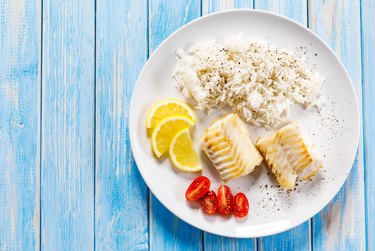
A flounder fillet is a healthy, high-protein, low-calorie, fast-cooking, light, delicately flavored piece of fish to which you can do just about anything your palate desires. These fish can be tricky to cook on the grill or on the stove, but it's entirely manageable to cook flounder in the oven.
Fish is naturally high in healthy omega-3 fatty acids, according to Mayo Clinic, and moisture, which makes them a great choice for baking or broiling. However, with even just a minute or two too long in the oven, flounder begins rapidly drying out, so pay close attention to your meal when preparing it.
Video of the Day
Video of the Day
Step 1: Prep the Oven
Preheat your oven to 425 degrees Fahrenheit about 30 minutes ahead of time if you're baking the flounder fillet. If you want to broil it, turn the broiler function on about 10 minutes in advance to preheat.
Considering preheating and cooking time, broiling takes less than half the time of baking; it's also better at crisping the outside of fish, so opt for broiling if you're breading the fillet or prefer a crusted exterior.
Step 2: Line the Pan
Line a baking tray with foil and apply a coating of cooking oil to bake the flounder, or grease the broiler rack with cooking oil. Don't skip greasing, as it prevents sticking; if a thin, delicate, flaky cooked flounder fillet sticks, there's considerable risk of it falling apart when you try to get it off the tray.
Step 3: Add Some Seasoning
Drizzle cooking oil or melted unsalted butter over the flounder. Pat on salt and pepper liberally, along with any other aromatics, herbs, spices or flavoring agents you'd like to use. Use blackening or Cajun seasoning mixes for spicy preparations or some combination of dill, basil, tarragon, thyme, oregano, marjoram and rosemary.
Try baked flounder with bread crumbs mixed with herbs, finely chopped pecans or pistachios, grated Parmesan cheese or a citrus zest. Or try baked flounder with lemon, garlic and butter. For a bite, brush the top of your fish with honey mustard, Dijon mustard or minced horseradish.
Step 4: Bake the Fish
Put the fillet on the lined baking tray or the broiler pan. To bake, put the fish into the middle of the oven; to broil, position the surface of the fillet 4 to 5 inches below the heating element.
Bake a flounder fillet for about 12 minutes or broil it for about six minutes. It's done as soon as the flesh flakes apart easily and is uniformly opaque inside. For safety, fish should be cooked to an internal temperature of at least 145 degrees Fahrenheit, according to the USDA Food Safety and Inspection Service.
Remove the fish from the tray or pan carefully with a broad spatula, supporting it fully underneath.
Read more: Which Is Better: Wild-Caught or Farmed Fish?
Practice Food Safety
In order to reduce risk of foodborne illness, store your fresh flounder in the refrigerator at 40 degrees Fahrenheit and cook it within one to two days, according to the Food and Drug Administration. If you aren't going to use it right away, freeze it for three to eight months at 0 degrees Fahrenheit.
Discard any leftover fish that has been at room temperature for more than two hours, as advised by the USDA Food Safety and Inspection Service. Consume leftovers within three to four days or freeze for up to three months.
Things You'll Need
Baking tray or broiler pan
Aluminum foil
Cooking oil
Salt and pepper
Flavoring agents
Spatula
- U.S. Food and Drug Administration: "Selecting and Serving Fresh and Frozen Seafood Safely"
- Mayo Clinic: "Dietary Fats: Know Which Types to Choose"
- USDA Food Safety and Inspection Service: "Safe Minimum Internal Temperature Chart"
- USDA Food Safety and Inspection Service: "Keep Food Safe! Food Safety Basics"
Was this article helpful?
150 Characters Max
0/150
Thank you for sharing!
Thank you for your feedback!